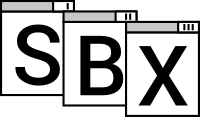SeqBox
From Just Solve the File Format Problem
(Difference between revisions)
m |
m |
||
| Line 15: | Line 15: | ||
An [[SBX]] container is composed of a collections of blocks with size sub/equal to that of a sector, so they can survive any level of fragmentation. Each block have a minimal header that include a unique file identifier, block sequence number, checksum, version. Additional, non critical info/[[metadata]] are contained in block 0 (like name, file size, crypto-hash, other attributes, etc.). | An [[SBX]] container is composed of a collections of blocks with size sub/equal to that of a sector, so they can survive any level of fragmentation. Each block have a minimal header that include a unique file identifier, block sequence number, checksum, version. Additional, non critical info/[[metadata]] are contained in block 0 (like name, file size, crypto-hash, other attributes, etc.). | ||
| − | If disaster strikes, recovery can be performed simply scanning a volume/image, reading sector sized slices and checking blocks signatures and then | + | If disaster strikes, recovery can be performed simply scanning a volume/image, reading sector sized slices and checking blocks signatures and then [[CRC]]s to detect valid SBX blocks. Then the blocks can be grouped by UIDs, sorted by sequence number and reassembled to form the original SeqBox containers. |
== Identification == | == Identification == | ||
Revision as of 14:51, 16 March 2017
SeqBox is a single file container/archive that can be reconstructed even after total loss of file system structures.An SBX container is composed of a collections of blocks with size sub/equal to that of a sector, so they can survive any level of fragmentation. Each block have a minimal header that include a unique file identifier, block sequence number, checksum, version. Additional, non critical info/metadata are contained in block 0 (like name, file size, crypto-hash, other attributes, etc.).
If disaster strikes, recovery can be performed simply scanning a volume/image, reading sector sized slices and checking blocks signatures and then CRCs to detect valid SBX blocks. Then the blocks can be grouped by UIDs, sorted by sequence number and reassembled to form the original SeqBox containers.
Identification
A SeqBox files start with bytes 53 42 78 or "SBx" in ASCII.
Format description
- SeqBox GitHub repository
Links
- SeqBox, Marco Pontello's Home Page
